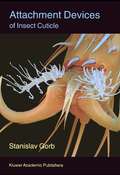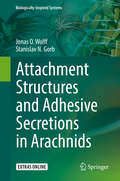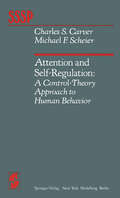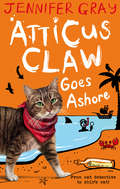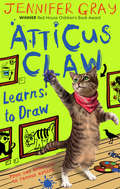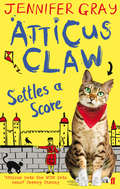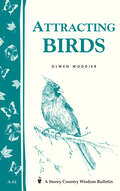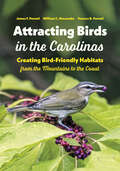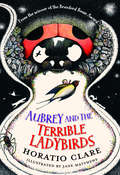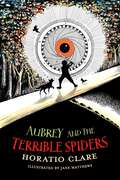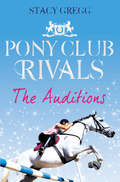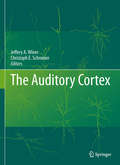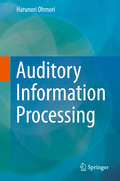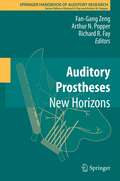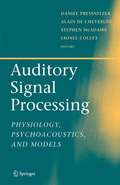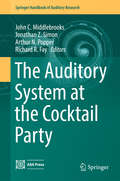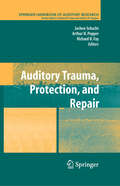- Table View
- List View
Attachment Devices of Insect Cuticle
by Stanislav S. GorbIn 1974 when I published my book, Biological Mechanism of Attachment, not many pages were required to report on the attachment devices of insect cuticles. As in most fields of research, our knowledge on this specific subject has simply exploded. Dr. Stanislav N. Gorb now describes the present day level of our knowledge, to which he has personally contributed so much, and a research team working on biological microtribology has gradually developed, also. With modern methods of measurement it is possible to enter the structure – function relationship much more deeply, even down to a molecular level, which was not possible two and a half decades ago. It is a well known fact that, in biology, the more sophisticated the measuring method, the greater the achievement of biological fundamental research, and its resulting evidence. Our knowledge remains at a certain level until new methods once more permit a forward leap. Biological knowledge develops in the form of a stepped curve rather than linear, as reflected in the studies carried out on the attachment devices of insect cuticles.
Attachment Structures and Adhesive Secretions in Arachnids (Biologically-Inspired Systems #7)
by Jonas O. Wolff Stanislav N. GorbThis book surveys attachment structures and adhesive secretions occurring in this class of animals and discusses the relationships between structure, properties, and function in the context of evolutionary trends, and biomimetic potential. Topics comprise mechanical attachment devices, such as clamps, claws, hooks, spines and wraps, as well as hairy and smooth adhesive pads, nano-fibrils, suction cups, and viscid and solidifying adhesives. Attachment is one of the major types of interactions between an organism and its environment. There are numerous studies that deal with this phenomenon in lizards, frogs, insects, barnacles, mussels and echinoderms, but the second largest class of animals, the Arachnida, was highly neglected so far. The authors demonstrated that most arachnid adhesive structures are highly analogous to those of insects and vertebrates, but there are also numerous unique developments with some intriguing working principles. Because arachnid attachment organs have a very strong potential of technological ideas for the development of new materials and systems, inspirations from biology could also be interesting for a broad range of topics in materials and surface engineering.
Attack Of The Alien Dung
by Gareth P. JonesThe Pet Defenders Code: 1.Planet Earth’s safety is your primary goal. Defend it. 2. Protect humans from the truth at all costs. Secret agent Biskit is not happy when he discovers his new partner Mitzy is a cat – everyone knows that cats and dogs don’t mix. But saving Earth from alien invasions must come first and the planet is under attack. A cluster of cow pats has flown into town and they’re whipping up a stink. It’s time for Biskit and Mitzy to put aside their differences and kick some alien butt!
Attention and Self-Regulation: A Control-Theory Approach to Human Behavior (Springer Series in Social Psychology)
by C. S. Carver M. F. Scheier"Seek simplicity and distrust it. " Alfred North Whitehead "It will become all too clear that an ability to see patterns in behavior, an ability that some might feel proud of, can lead more easily to a wrong description than a right one. " William T. Powers The goal of the theorist-the scholar-is to take a collection of observations of the world, and perceive order in them. This process necessarily imposes an artificial simplicity upon those observations. That is, specific observations are weighed differently from each other whenever a theoretical account is abstracted from raw experiences. Some observed events are misunderstood or distorted, others are seen as representing random fluctuations and are ignored, and yet others are viewed as centrally important. This abstraction and oversimplification of reality is inevitable in theory construction. Moreover, the abstracted vision builds upon itself. That is, as a structure begins to emerge from continued observation, the structure itself guides the search for new information. The result is a construction that is more elaborate than what existed before, but it still is usually simpler than reality. It is important for scholars to believe in the value of their task, and in the general correctness of the vision that guides their work. This commitment, and the hope of progress that follows from it, make it possible to continue even when the work is difficult and slow.
Atticus Claw Breaks the Law (Atticus Claw: World's Greatest Cat Detective #1)
by Jennifer GrayWhen Atticus receives an anonymous message summoning him to a meeting in a sleepy English coastal town, he packs his bags and sets off. The world's greatest cat burglar likes a good mystery and this time curiosity has got the better of him. The writer of the message, it turns out, is none other than Jimmy the Magpie, gang leader. He is morning the death of his friend Beaky, who has been run over by a Rolls Royce. Now he wants Atticus to steal all the jewels in town and leave the humans baffled. What could be more straightforward? But when Atticus moves in with Inspector Cheddar and his family, he starts to wonder if a life of crime is really for him . . .
Atticus Claw Goes Ashore (Atticus Claw: World's Greatest Cat Detective #4)
by Jennifer GrayAtticus is on beach tidying duty with the kittens when he finds a message in a bottle from Fishhook Frank. Fishhook is marooned on a desert island, but he promises Atticus treasure in exchange for his rescue! The treasure in question is the Casket of Desires, which contains a sleeping mermaid who has the power to grant any wish. But it is hidden in the deepest darkest part of the ocean, protected by the most hideous, fearsome sea-creatures known to pirate lore. Atticus sets out to rescue Fishhook Frank and find the Casket of Desires with his owners, the Cheddar family. But it's not all plain sailing. The pirate with the biggest beard-jumper in the nautical world - Captain Black Beard-Jumper - is also on the look out for the Casket and he'll curse anyone who gets in his way...
Atticus Claw Hears a Roar (Atticus Claw: World's Greatest Cat Detective #7)
by Jennifer GrayEveryone's favourite cat detective is back! Atticus finds a mysterious case in the attic and inside is a book leading to the treasure of the lost jaguar gods and to a jungle adventure with the Cheddar family. The seventh book in the much loved, bestselling Atticus Claw series.
Atticus Claw Learns to Draw (Atticus Claw: World's Greatest Cat Detective #5)
by Jennifer GrayAtticus Claw Leans to Draw by Jennifer Gray is the latest in this popular series about master-criminal turned police-cat, Atticus Claw.Famous works of art are going missing. Atticus is on the case. The prime suspect is Ricardo Butteredsconi - Italian theme park entrepreneur and art connoisseur. Then Inspector Cheddar goes missing from the Tate Modern, and Atticus and his friends suspect Butteredsconi and his evil pet pig. In the scariest adventure of his nine lives, Atticus has to act fast if he wants to stop Inspector Cheddar becoming a waxwork!'Should be a hit for anyone who is, or has been, ten years old.' The Bookbag'Worth it for the delightfully feline puns alone.' Herald'As many ups and downs, triumphs and disasters, thrills and spills as ever.' Carousel'Atticus Claw is a masterpiece!' Sam, age 12'Very funny and interesting.' Aram age 9'Atticus is naughty and really cool!' Lucas, age 7'Atticus Claw is fantastic.' Charlotte, age 8
Atticus Claw Lends a Paw (Atticus Claw: World's Greatest Cat Detective #2)
by Jennifer GrayAtticus Grammatticus Cattypuss Claw, the world's greatest POLICE cat, is back. When the kittens at the local cats' home are wrongly suspected of a knitting crime spree, Inspector Cheddar is baffled. Atticus must step in to find the real culprits. In an adventure that takes him from Littleton-on-Sea to the sands of the Egyptian desert, Atticus has to use all his tabby talents to keep one paw ahead of Ginger Biscuit and Jimmy Magpie and his gang. Can Atticus reach the lost city of cats and save the priceless treasure from the villains before it's too late?
Atticus Claw On the Misty Moor (Atticus Claw: World's Greatest Cat Detective #6)
by Jennifer GrayThe Cheddar family are celebrating New Year's Eve in a Scottish castle! Surely even Atticus can't find trouble here.But with rumours of hidden treasure, an ancient family curse, and sightings of a mysterious giant cat on the moor, it seems Police Cat Sergeant Claw's detective skills will be needed once again.And danger lurks everywhere on the misty moor. . .
Atticus Claw Settles a Score (Atticus Claw: World's Greatest Cat Detective #3)
by Jennifer GrayBook 2 in the much-loved Atticus Claw series: the hilarious and eagerly-awaited sequel to Atticus Claw Breaks the Law. Perfect for readers age 7+, children will love Atticus's second adventure which takes him from tea with the Queen to the dungeons of the Tower of London.Atticus Grammatticus Cattypus Claw, the world's greatest reformed cat burglar is back. This time, the tabby with talent is on the right side of the law. And when Jimmy Magpie and his gang are busted out of jail by a mysterious villain and an evil cat called Ginger Biscuit, Atticus knows from bitter experience he's going to need all his skill and courage to catch them.Can Atticus overcome his murky past with the help of the Cheddar family in order to prevent the biggest crime in history and settle a score of his own?
Attracting Birds: Storey Country Wisdom Bulletin A-64 (Storey Country Wisdom Bulletin)
by Olwen WoodierSince 1973, Storey's Country Wisdom Bulletins have offered practical, hands-on instructions designed to help readers master dozens of country living skills quickly and easily. There are now more than 170 titles in this series, and their remarkable popularity reflects the common desire of country and city dwellers alike to cultivate personal independence in everyday life.
Attracting Birds in the Carolinas: Creating Bird-Friendly Habitats from the Mountains to the Coast
by James F. Parnell William C. Alexander Frances B. ParnellCovering the Carolinas from up-country to the Piedmont to the Coastal Plain, this book is an in-depth yet accessible primer on the many ways that Carolinians can attract birds--from large wildlife refuges to private sanctuaries, and from farms to suburban homes and even apartments. The first book to focus specifically on attracting birds in both states, Attracting Birds in the Carolinas includes information on birds' basic needs and their annual reproduction and migration cycles, and provides helpful tips on how to modify your outdoor space to invite avian visitors. In addition to helpful information on attracting particular species, this guide offers practical advice for managing problem species—both avian, such as the European Starling and Mute Swan, and nonavian, such as squirrels and snakes.
Aubrey and the Terrible Ladybirds (Aubrey #0)
by Horatio ClareIt’s the holidays, you’ve just become as small as an earwig, the swallows are back (and offering you rides), and a spider wakes you up in the middle of the night and asks you to save the world. As if that weren’t enough, the Ladybirdz fly in from Bohemia to find the local ladybirds do not want them... The world of Aubrey, the boy who can talk to animals (and understand the answers) grows larger and faster in this moving and hilarious story from award-winning children’s author Horatio Clare.
Aubrey and the Terrible Spiders (Aubrey and the Terrible Yoot #3)
by Horatio ClareWhen Aubrey is stung by a very polite wasp, he realises there is something strange going on in Rushing Wood. And as he's the only boy he knows of who can talk with animals, he is determined to find out what.With help from his friends Ariadne the house spider, Silvio the silverfish and Lupo the huskey pup, the young warrior sets out to fight the terrible robospiders and their genius creator Big Xe and, just maybe, save the world.
The Auditions (Pony Club Rivals #1)
by Stacy GreggCompetition is fierce at the All-Stars Academy – can the new girl outshine her rivals?
Auditory Computation (Springer Handbook of Auditory Research #6)
by Harold L. Hawkins Teresa A. McMullen Richard R. FayThe auditory system presents many features of a complex computational environment, as well as providing numerous opportunities for computational analysis. This volume represents an overview of computational approaches to understanding auditory system function. The chapters share the common perspective that complex information processing must be understood at multiple levels; that disciplines such as neurobiology, psychophysics, and computer science make vital contributions; and that the end product of computational analysis should be the development of formal models.
The Auditory Cortex
by Jeffery A. Winer and Christoph E. SchreinerThere has been substantial progress in understanding the contributions of the auditory forebrain to hearing, sound localization, communication, emotive behavior, and cognition. The Auditory Cortex covers the latest knowledge about the auditory forebrain, including the auditory cortex as well as the medial geniculate body in the thalamus. This book will cover all important aspects of the auditory forebrain organization and function, integrating the auditory thalamus and cortex into a smooth, coherent whole. Volume One covers basic auditory neuroscience. It complements The Auditory Cortex, Volume 2: Integrative Neuroscience, which takes a more applied/clinical perspective.
Auditory Development in Infancy (Advances in the Study of Communication and Affect #10)
by Sandra E. Trehub Bruce SchneiderThe small but growing body of information about auditory processes in infancy is a tribute to the ingenuity and persistence of investigators in this realm. Undeter red by the frequent expressions of boredom, rage, and indifference in their subjects, these investigators nevertheless continue to seek answers to the intrigu ing but difficult questions about the course of auditory development. In the spring of 1981, a group of leading scholars and researchers in audi tion gathered to discuss the topic, Auditory Development in Infancy, at the 11th annual psychology symposium at Erindale College, University of Toronto. They came from both sides of the Atlantic and from various disciplines, including audiology, neurology, physics, and psychology. They shared their views on theory and data, as well as their perspectives from the laboratory and clinic. One unexpected bonus was an unusually distinguished audience of researchers and clinicians who contributed to lively discussion within and beyond the formal sessions.
Auditory Information Processing
by Harunori OhmoriThis book explains neural function at the level of ion channels and membrane excitability in neurons along the ascending auditory pathway. Airborne sound information is captured by the ears, transformed to neural electrical signals, and then processed in the brain. Readers will find full descriptions of these processes of signal transduction and transformation. First, it is described how, at the level of hair cells, the receptor cells in the cochlea, the sound-evoked vibration is transduced to electrical signals and transmitted to the auditory nerve fibers. In the second section it is explained how the electrical activity of these fibers is processed at the cochlear nucleus in order to extract the temporal and level information of sound separately and then transmitted to the third nucleus for processing of the interaural differences, such as the interaural time difference and the interaural level difference. The third section summarizes the transformation of auditory temporal information to the rate of neural firing activity in the midbrain and the higher nuclei, including the cortex, based on in vivo results. Finally, emerging new technologies to investigate auditory signal processing are reviewed and discussed.
Auditory Pathway: Structure and Function
by Josef Syka R. Bruce MastertonSince the last symposium on "Neuronal Mechanisms of Hearing" held in Prague in 1980 and published in the volume of the same name (J. Syka and L. Aitkin, Eds. , Plenum Press, 1981), remarkable progress has been achieved in the understanding of the auditory system. A variety of new ideas and new methods have emerged. This progress can be easily documented by comparing the volume based on the 1980 Symposium with the program for the 1987 Symposium. For example, there were 45 contributions to auditory physiology in each symposium but there were 27 contributions focusing on anatomy in 1987 as compared to 7 in 1980, and perhaps most telling, there were 12 contributions to the neurochemistry of the system in 1987 while there were only 3 in 1980. In terms of percentages of contributions, neuroanatomy rose from 13% to 32% and neurochemistry (or chemical anatomy) rose from 5% in 1980 to 14% in 1987. These increases in the numbers and proportions of anatomical and neurochemical contributions undoubtedly reflects the increasing availabil ity and rising expertise in the new neuroanatomica1 and biochemical techniques most notably, tract-tracing by exploitation of axonal transport or by intracellular micro-injection methods, and neurotransmitter identifi cation by use of immunocytochemistry or receptor-binding techniques. New ideas have emerged on the function of cochlear hair cells particularly in connection with olivococh1ear bundle stimulation and supported by findings of contractile proteins in outer hair cells.
Auditory Prostheses: New Horizons (Springer Handbook of Auditory Research #39)
by Fan-Gang Zeng, Arthur N. Popper and Richard R. FayCochlear implants are currently the standard treatment for profound sensorineural hearing loss. In the last decade, advances in auditory science and technology have not only greatly expanded the utility of electric stimulation to other parts of the auditory nervous system in addition to the cochlea, but have also demonstrated drastic changes in the brain in responses to electric stimulation, including changes in language development and music perception. Volume 20 of SHAR focused on basic science and technology underlying the cochlear implant. However, due to the newness of the ideas and technology, the volume did not cover any emerging applications such as bilateral cochlear implants, combined acoustic-electric stimulation, and other types of auditory prostheses, nor did it review brain plasticity in responses to electric stimulation and its perceptual and language consequences. This proposed volume takes off from Volume 20, and expands the examination of implants into new and highly exciting areas. This edited book starts with an overview and introduction by Dr. Fan-Gang Zeng. Chapters 2-9 cover technological development and the advances in treating the full spectrum of ear disorders in the last ten years. Chapters 10-15 discuss brain responses to electric stimulation and their perceptual impact. This volume is particularly exciting because there have been quantum leap from the traditional technology discussed in Volume 20. Thus, this volume is timely and will be of real importance to the SHAR audience.
Auditory Signal Processing: Physiology, Psychoacoustics, and Models
by Daniel Pressnitzer Lionel Collet Stephen McAdams Alain De CheveigneThis book contains the papers that were presented at the XIIIth International Symposium on Hearing (ISH), which was held in Dourdan, France, between August 24 and 29, 2003. From its first edition in 1969, the Symposium has had a distinguished tradition of bringing together auditory psychologists and physiologists. Hearing science now also includes computational modeling and brain imaging, and this is reflected in the papers collected. The rich interactions between participants during the meeting were yet another indication of the appositeness of the original idea to confront approaches around shared scientific issues. A total of 62 solicited papers are included, organized into 12 broad thematic areas ranging from cochlear signal processing to plasticity and perceptual learning. The themes follow the sessions and the chronological order of the paper presentations during the symposium. A notable feature of the ISH books is the transcription of the discussions between participants. A draft version of the book is circulated before the meeting, and all participants are invited to make written comments, before or during the presentations. This particularity is perhaps what makes the ISH book series so valuable as a truthful picture of the evolution of issues in hearing science. We tried to uphold this tradition, which was all the easier because of the excellent scientific content of the discussions.
The Auditory System at the Cocktail Party (Springer Handbook of Auditory Research #60)
by John C. Middlebrooks Jonathan Z. Simon Arthur N. Popper Richard R. FayThe Auditory System at the Cocktail Party is a rather whimsical title that points to the very serious challenge faced by listeners in most everyday environments: how to hear out sounds of interest amid a cacophony of competing sounds. The volume presents the mechanisms for bottom-up object formation and top-down object selection that the auditory system employs to meet that challenge. Ear and Brain Mechanisms for Parsing the Auditory Scene by John C. Middlebrooks and Jonathan Z. Simon Auditory Object Formation and Selection by Barbara Shinn-Cunningham, Virginia Best, and Adrian K. C. Lee Energetic Masking and Masking Release by John F. Culling and Michael A. Stone Informational Masking in Speech Recognition by Gerald Kidd, Jr. and H. Steven Colburn Modeling the Cocktail Party Problem by Mounya Elhilali Spatial Stream Segregation by John C. Middlebrooks Human Auditory Neuroscience and the Cocktail Party Problem by Jonathan Z. Simon Infants and Children at the Cocktail Party by Lynne Werner Older Adults at the Cocktail Party by M. Kathleen Pichora-Fuller, Claude Alain, and Bruce A. Schneider Hearing with Cochlear Implants and Hearing Aids in Complex Auditory Scenes by Ruth Y. Litovsky, Matthew J. Goupell, Sara M. Misurelli, and Alan Kan About the Editors: John C. Middlebrooks is a Professor in the Department of Otolaryngology at the University of California, Irvine, with affiliate appointments in the Department of Neurobiology and Behavior, the Department of Cognitive Sciences, and the Department of Biomedical Engineering. Jonathan Z. Simon is a Professor at the University of Maryland, College Park, with joint appointments in the Department of Electrical and Computer Engineering, the Department of Biology, and the Institute for Systems Research. Arthur N. Popper is Professor Emeritus and Research Professor in the Department of Biology at the University of Maryland, College Park. Richard R. Fay is Distinguished Research Professor of Psychology at Loyola University, Chicago. About the Series: The Springer Handbook of Auditory Research presents a series of synthetic reviews of fundamental topics dealing with auditory systems. Each volume is independent and authoritative; taken as a set, this series is the definitive resource in the field.
Auditory Trauma, Protection, and Repair (Springer Handbook of Auditory Research #31)
by Jochen Schacht Richard R. FayThe past decade has brought great advances in our understanding of the mechanisms underlying auditory pathologies. This volume presents recent developments in research and their potential translation to the clinical setting. It brings together the basic and clinical sciences very nicely in that while most chapters are written by basic scientists, each topic has a pretty direct clinical application or implication.
